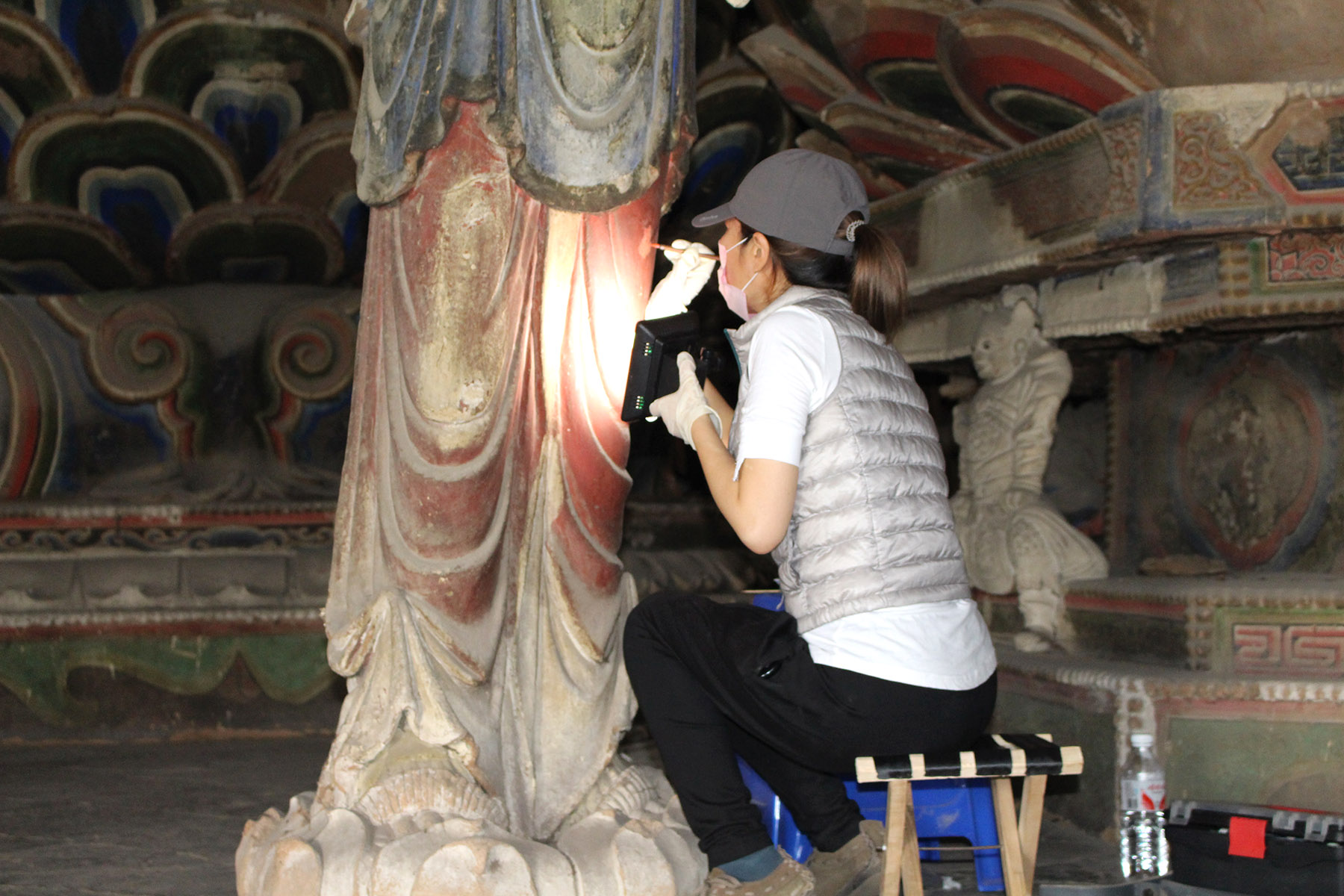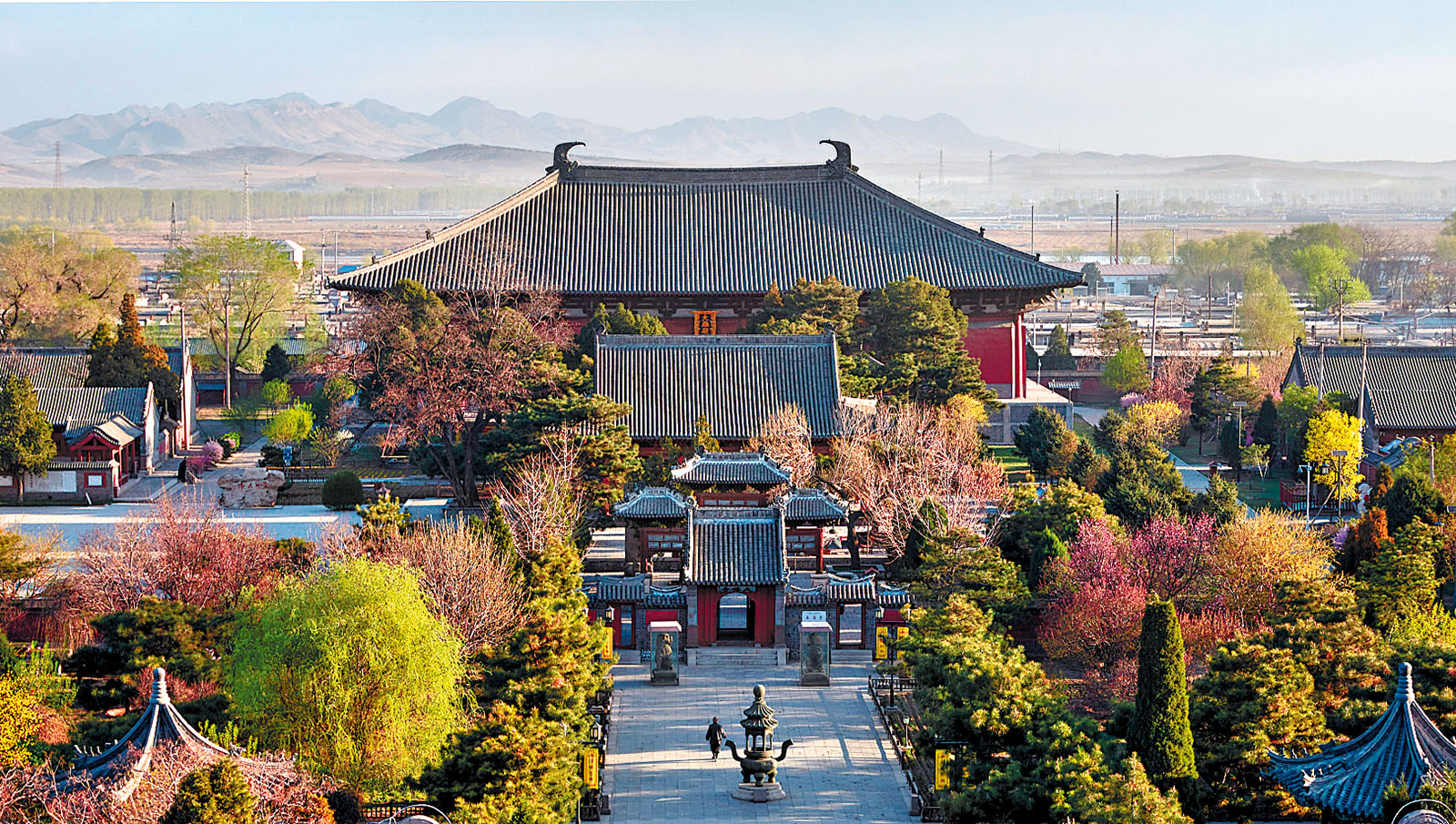Structure sees its growing appeal attracting increasing numbers of visitors, Wang Ru reports in Jinzhou, Liaoning.

People often recount legendary tales of Fengguo Temple, a structure more than 1,000 years old that is situated in Yixian county, Jinzhou, Liaoning province. It has miraculously withstood the ravages of war, earthquakes and various disasters throughout history and continues to thrive to this day.
One particularly perilous moment occurred during the War of Liberation (1946-49) in 1948, when bombs were dropped on the temple's Mahavira Hall. One bomb penetrated the roof, breaking a Buddhist statue's arm before finally landing on the lotus throne. Miraculously, none of the bombs detonated, saving the hall from being destroyed. This remarkable story has been recorded in the county annals of Yixian.
Today, although the old complex bears the marks of time and is undergoing renovation, it shines even more brightly in people's eyes and has attracted more and more visitors to pay tribute to its rich history and culture.
READ MORE: Yibin has much appeal for history buffs
The temple was built in 1020 during the prosperous time of the Liao Dynasty (916-1125). "Legends say it was built by Liao Emperor Shengzong (972-1031) in commemoration of his mother, Empress Dowager Xiao (953-1009), a powerful politician who once ruled Liao for 27 years," says Li Zhenhua, a tour guide at the temple, adding that Yixian used to be a fief of the Xiao family and that is probably why the temple was built.

Established by the Khitan people, a nomadic ethnic tribe, the Liao Dynasty once ruled a vast area of today's Mongolia, Northeast and North China for more than 200 years until it was conquered by the Jin Dynasty (1115-1234). Yixian, located in the heartland of the Liao Dynasty, lay between the Liao upper capital in Baarin Left Banner, Inner Mongolia autonomous region, and its east capital in Liaoyang, Liaoning, according to Li.
The temple complex now comprises an outer gate built in 1984, a Qing Dynasty (1644-1911) inner gate and a memorial gateway in memory of a Qing princess. Additionally, there are Yuan Dynasty (1271-1368) murals adorning the walls of the main hall and the main hall itself, dating back to the Liao era. The most significant structure is the Mahavira Hall, a colossal wooden building.
Spanning an area of 1,800 square meters, the hall is 55 meters long and 33 meters wide. Inside the hall, seven painted clay Buddhist statues stand side by side, each towering at an average height of 9 meters, she says.
"The attire of the statues is particularly elegant and luxurious, reflecting the Buddhist sculptural style of the Tang Dynasty (618-907), which was then inherited by the Liao Dynasty," says Li.
Wen Hui, director of Yixian's archaeology and cultural relics protection and service center, says, "The Mahavira Hall is one of the largest wooden structures among ancient China's Buddhist temple remains. The clay statues, with their exquisiteness and grand scale, are rare treasures anywhere in the world."
Moreover, the beams and ceiling of the hall are painted with Buddhist patterns like Flying Apsaras, some of which are "rare to see", according to Buddhist master Hsing Yun (1927-2023), who visited the temple three times. Altogether, the painted area covers 2,400 sq m, says Li.

Wen says that, in front of each Buddhist statue, there are two painted clay statues of flanking-attendant Bodhisattvas, standing at a height of 2.5 meters. On two sides of the hall, two heavenly kings are also present. Currently, efforts are underway to repair and preserve the statues.
"We have seen cracks and missing parts on the surface of the statues, and dust and bird droppings may corrode the painted patterns. Therefore, we have been cleaning them and restoring the fallen parts to extend their lifespan," says Wen.
Another project aims to protect the Yuan Dynasty murals on the hall's walls. He says that, at the beginning, there were Liao Dynasty murals as well, but a major earthquake in the Yuan Dynasty destroyed them. Then, Yuan people made new murals, which have been kept to this day.
"There have been instances of peeling and cracking, as well as pest infestation on the original murals. Subsequently, we have carried out a research project focusing on their preliminary conservation," says Wen.
A Jin Dynasty tablet written by Zhang Shao, an official at that time, records the past grandeur of the temple. The tablet says that the temple once boasted an expansive scale, featuring lofty and magnificent buildings that housed more than 1,000 monks.
Li says that most of the buildings were destroyed by the Jin people after they conquered Liao, but nobody knows why they left the Mahavira Hall intact.
"Although the Liao Dynasty left behind few historical records due to the Jin Dynasty's destruction, these Liao buildings vividly recount the prosperous past of the Liao era," says Li.
Three important Liao Dynasty temples still exist today — the Huayan Temple in Datong, Shanxi province, Dule Temple in Tianjin and Fengguo Temple, among which only the Fengguo Temple still keeps its main hall, says Wen.

Moreover, among the existing eight wooden Liao structures in China, the Mahavira Hall of Fengguo Temple is the largest in scale, according to Li.
The local government has attached great importance to the protection and promotion of the temple. Guo Kuo, Party secretary of Yixian, says they have been especially cautious in developing and protecting the surrounding areas of the Fengguo Temple, trying to maintain their original features instead of allowing excessive commercial activities.
They plan to build a museum to show more cultural relics of the temple that have been kept in storehouses and step up efforts in fire prevention as wooden structures are vulnerable to fire.
Local people have actively participated in promoting the temple. For example, Li, also a livestreamer with more than 450,000 followers on short-video platform Kuaishou, has been actively introducing cultural heritage in Yixian, especially Fengguo Temple. More people have volunteered to contribute to these efforts.
ALSO READ: Digging up the Buddhist past
With these endeavors, the temple welcomes more and more visitors. In the past four months this year, the temple has received 203,000 visits, generating tourist revenue of more than 2 million yuan ($276,500), a 451 percent increase compared to the same period last year, according to county authorities.
"Protection takes precedence over development and profit. If I have the opportunity to make it better, that would be wonderful. But if that's not possible, the priority is to avoid causing any damage and not let our ancestors' cultural legacy be destroyed," says Guo.
Contact the writer at wangru1@chinadaily.com.cn


